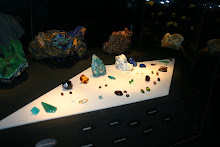
Wednesday, November 12, 2008
Fun Facts...
Thanksgiving Fun Facts
Over the Years
Though many competing claims exist, the most familiar story of the first Thanksgiving took place in Plymouth Colony, in present-day Massachusetts, in 1621. More than 200 years later, President Abraham Lincoln declared the final Thursday in November as a national day of thanksgiving. Congress finally made Thanksgiving Day an official national holiday in 1941.
Sarah Josepha Hale, the enormously influential magazine editor and author who waged a tireless campaign to make Thanksgiving a national holiday in the mid-19th century, was also the author of the classic nursery rhyme "Mary Had a Little Lamb."
In 2001, the U.S. Postal Service issued a commemorative Thanksgiving stamp. Designed by the artist Margaret Cusack in a style resembling traditional folk-art needlework, it depicted a cornucopia overflowing with fruits and vegetables, under the phrase "We Give Thanks."
» back to top
On the Roads
Despite record-high gas prices (more than $3.00 per gallon) in 2007, the American Automobile Association (AAA) estimated that 38.7 million Americans would travel 50 miles or more from home for the Thanksgiving holiday, a slight increase (1.5 percent) over the previous year.
Of those Americans traveling for Thanksgiving in 2007, approximately 80 percent (31.2 million) were expected to go by motor vehicle, 12.1 percent (4.7 million) by airplane and the rest (2.8 million) by train, bus or other mode of transportation.
» back to top
On the Table
According to the U.S. Census Bureau, Minnesota is the top turkey-producing state in America, with a planned production total of 49 million in 2008. Just six states—Minnesota, North Carolina, Arkansas, Virginia, Missouri and Indiana—will probably produce two-thirds of the estimated 271 million birds that will be raised in the U.S. this year.
The National Turkey Federation estimated that 46 million turkeys—one fifth of the annual total of 235 million consumed in the United States in 2007—were eaten at Thanksgiving.
In a survey conducted by the National Turkey Federation, nearly 88 percent of Americans said they eat turkey at Thanksgiving. The average weight of turkeys purchased for Thanksgiving is 15 pounds, which means some 690 million pounds of turkey were consumed in the U.S. during Thanksgiving in 2007.
The cranberry is one of only three fruits—the others are the blueberry and the Concord grape—that are entirely native to North American soil, according to the Cape Cod Cranberry Growers' Association.
According to the Guinness Book of World Records, the largest pumpkin pie ever baked weighed 2,020 pounds and measured just over 12 feet long. It was baked on October 8, 2005 by the New Bremen Giant Pumpkin Growers in Ohio, and included 900 pounds of pumpkin, 62 gallons of evaporated milk, 155 dozen eggs, 300 pounds of sugar, 3.5 pounds of salt, 7 pounds of cinnamon, 2 pounds of pumpkin spice and 250 pounds of crust.
» back to top
Around the Country
Three towns in the U.S. take their name from the traditional Thanksgiving bird, including Turkey, Texas (pop. 465); Turkey Creek, Louisiana (pop. 363); and Turkey, North Carolina (pop. 270).
Originally known as Macy's Christmas Parade—to signify the launch of the Christmas shopping season—the first Macy's Thanksgiving Day Parade took place in New York City in 1924. It was launched by Macy's employees and featured animals from the Central Park Zoo. Today, some 3 million people attend the annual parade and another 44 million watch it on television.
Tony Sarg, a children's book illustrator and puppeteer, designed the first giant hot air balloons for the Macy's Thanksgiving Day Parade in 1927. He later created the elaborate mechanically animated window displays that grace the façade of the New York store from Thanksgiving to Christmas.
Snoopy has appeared as a giant balloon in the Macy's Thanksgiving Day Parade more times than any other character in history. As the Flying Ace, Snoopy made his sixth appearance in the 2006 parade.
The first National Football League game held on Thanksgiving Day was in 1934, when the Detroit Lions played the Chicago Bears at the University of Detroit stadium, in front of 26,000 fans. The NBC radio network broadcast the game on 94 stations across the country. Since that time, the Lions have played a game every Thanksgiving (except between 1939 and 1944); in 1956, fans watched the game on television for the first time.
Over the Years
Though many competing claims exist, the most familiar story of the first Thanksgiving took place in Plymouth Colony, in present-day Massachusetts, in 1621. More than 200 years later, President Abraham Lincoln declared the final Thursday in November as a national day of thanksgiving. Congress finally made Thanksgiving Day an official national holiday in 1941.
Sarah Josepha Hale, the enormously influential magazine editor and author who waged a tireless campaign to make Thanksgiving a national holiday in the mid-19th century, was also the author of the classic nursery rhyme "Mary Had a Little Lamb."
In 2001, the U.S. Postal Service issued a commemorative Thanksgiving stamp. Designed by the artist Margaret Cusack in a style resembling traditional folk-art needlework, it depicted a cornucopia overflowing with fruits and vegetables, under the phrase "We Give Thanks."
» back to top
On the Roads
Despite record-high gas prices (more than $3.00 per gallon) in 2007, the American Automobile Association (AAA) estimated that 38.7 million Americans would travel 50 miles or more from home for the Thanksgiving holiday, a slight increase (1.5 percent) over the previous year.
Of those Americans traveling for Thanksgiving in 2007, approximately 80 percent (31.2 million) were expected to go by motor vehicle, 12.1 percent (4.7 million) by airplane and the rest (2.8 million) by train, bus or other mode of transportation.
» back to top
On the Table
According to the U.S. Census Bureau, Minnesota is the top turkey-producing state in America, with a planned production total of 49 million in 2008. Just six states—Minnesota, North Carolina, Arkansas, Virginia, Missouri and Indiana—will probably produce two-thirds of the estimated 271 million birds that will be raised in the U.S. this year.
The National Turkey Federation estimated that 46 million turkeys—one fifth of the annual total of 235 million consumed in the United States in 2007—were eaten at Thanksgiving.
In a survey conducted by the National Turkey Federation, nearly 88 percent of Americans said they eat turkey at Thanksgiving. The average weight of turkeys purchased for Thanksgiving is 15 pounds, which means some 690 million pounds of turkey were consumed in the U.S. during Thanksgiving in 2007.
The cranberry is one of only three fruits—the others are the blueberry and the Concord grape—that are entirely native to North American soil, according to the Cape Cod Cranberry Growers' Association.
According to the Guinness Book of World Records, the largest pumpkin pie ever baked weighed 2,020 pounds and measured just over 12 feet long. It was baked on October 8, 2005 by the New Bremen Giant Pumpkin Growers in Ohio, and included 900 pounds of pumpkin, 62 gallons of evaporated milk, 155 dozen eggs, 300 pounds of sugar, 3.5 pounds of salt, 7 pounds of cinnamon, 2 pounds of pumpkin spice and 250 pounds of crust.
» back to top
Around the Country
Three towns in the U.S. take their name from the traditional Thanksgiving bird, including Turkey, Texas (pop. 465); Turkey Creek, Louisiana (pop. 363); and Turkey, North Carolina (pop. 270).
Originally known as Macy's Christmas Parade—to signify the launch of the Christmas shopping season—the first Macy's Thanksgiving Day Parade took place in New York City in 1924. It was launched by Macy's employees and featured animals from the Central Park Zoo. Today, some 3 million people attend the annual parade and another 44 million watch it on television.
Tony Sarg, a children's book illustrator and puppeteer, designed the first giant hot air balloons for the Macy's Thanksgiving Day Parade in 1927. He later created the elaborate mechanically animated window displays that grace the façade of the New York store from Thanksgiving to Christmas.
Snoopy has appeared as a giant balloon in the Macy's Thanksgiving Day Parade more times than any other character in history. As the Flying Ace, Snoopy made his sixth appearance in the 2006 parade.
The first National Football League game held on Thanksgiving Day was in 1934, when the Detroit Lions played the Chicago Bears at the University of Detroit stadium, in front of 26,000 fans. The NBC radio network broadcast the game on 94 stations across the country. Since that time, the Lions have played a game every Thanksgiving (except between 1939 and 1944); in 1956, fans watched the game on television for the first time.
The Pilgrim's Menu...
The Pilgrims' Menu
Foods That May Have Been on the Menu
Seafood: Cod, Eel, Clams, LobsterWild Fowl: Wild Turkey, Goose, Duck, Crane, Swan, Partridge, EaglesMeat: Venison, SealGrain: Wheat Flour, Indian CornVegetables: Pumpkin, Peas, Beans, Onions, Lettuce, Radishes, CarrotsFruit: Plums, GrapesNuts: Walnuts, Chestnuts, AcornsHerbs and Seasonings: Olive Oil, Liverwort, Leeks, Dried Currants, Parsnips
What Was Not on the Menu
Surprisingly, the following foods, all considered staples of the modern Thanksgiving meal, didn't appear on the pilgrims's first feast table:
Ham: There is no evidence that the colonists had butchered a pig by this time, though they had brought pigs with them from England.Sweet Potatoes/Potatoes: These were not common.Corn on the Cob: Corn was kept dried out at this time of year.Cranberry Sauce: The colonists had cranberries but no sugar at this time.Pumpkin Pie: It's not a recipe that exists at this point, though the pilgrims had recipes for stewed pumpkin.Chicken/Eggs: We know that the colonists brought hens with them from England, but it's unknown how many they had left at this point or whether the hens were still laying.Milk: No cows had been aboard the Mayflower, though it's possible that the colonists used goat milk to make cheese.
Source: Kathleen Curtin, Food Historian at Plimoth Plantation.
Foods That May Have Been on the Menu
Seafood: Cod, Eel, Clams, LobsterWild Fowl: Wild Turkey, Goose, Duck, Crane, Swan, Partridge, EaglesMeat: Venison, SealGrain: Wheat Flour, Indian CornVegetables: Pumpkin, Peas, Beans, Onions, Lettuce, Radishes, CarrotsFruit: Plums, GrapesNuts: Walnuts, Chestnuts, AcornsHerbs and Seasonings: Olive Oil, Liverwort, Leeks, Dried Currants, Parsnips
What Was Not on the Menu
Surprisingly, the following foods, all considered staples of the modern Thanksgiving meal, didn't appear on the pilgrims's first feast table:
Ham: There is no evidence that the colonists had butchered a pig by this time, though they had brought pigs with them from England.Sweet Potatoes/Potatoes: These were not common.Corn on the Cob: Corn was kept dried out at this time of year.Cranberry Sauce: The colonists had cranberries but no sugar at this time.Pumpkin Pie: It's not a recipe that exists at this point, though the pilgrims had recipes for stewed pumpkin.Chicken/Eggs: We know that the colonists brought hens with them from England, but it's unknown how many they had left at this point or whether the hens were still laying.Milk: No cows had been aboard the Mayflower, though it's possible that the colonists used goat milk to make cheese.
Source: Kathleen Curtin, Food Historian at Plimoth Plantation.
Tuesday, November 4, 2008
My Mystery Quilt...
Subscribe to:
Comments (Atom)





















































































































